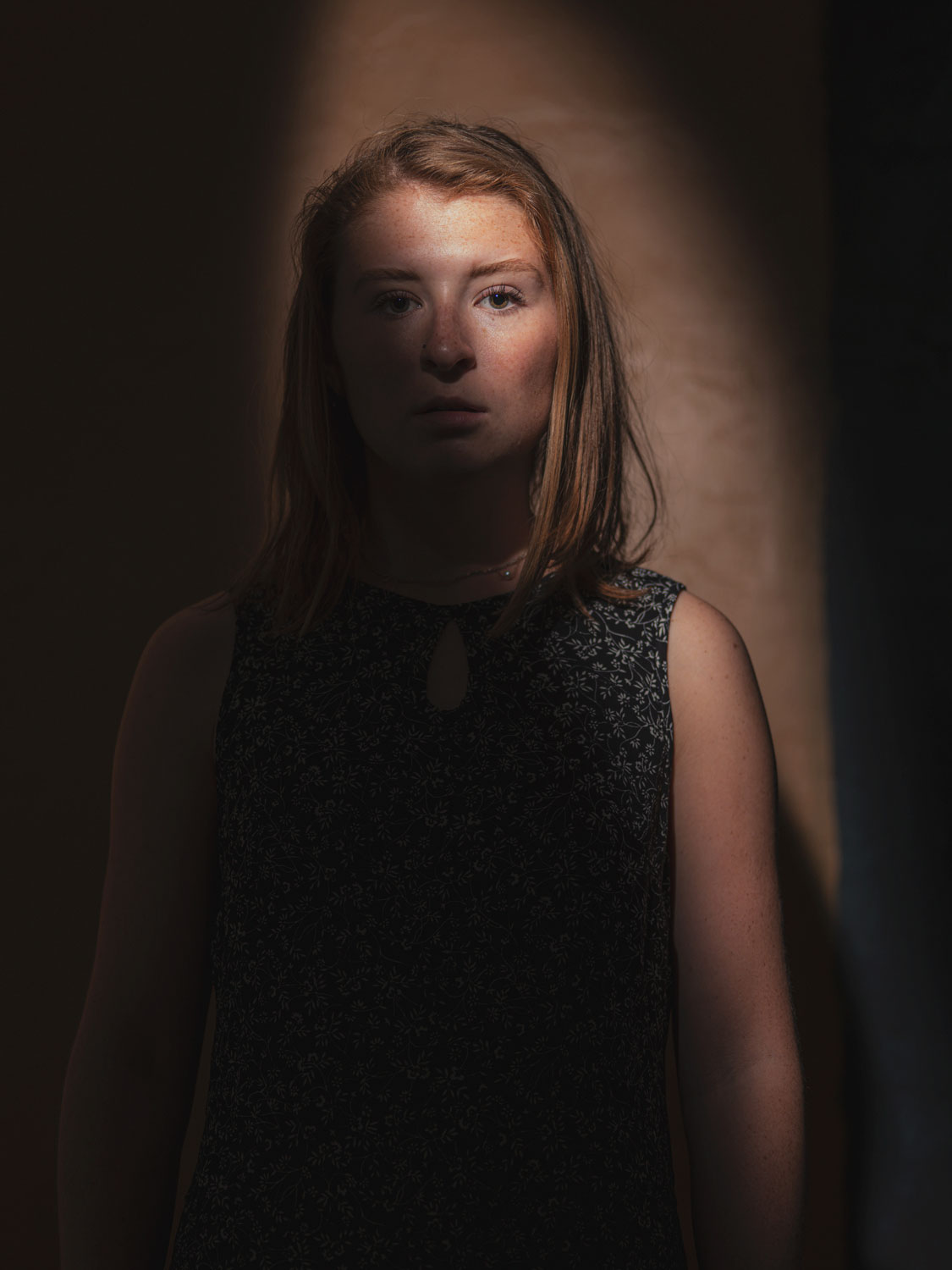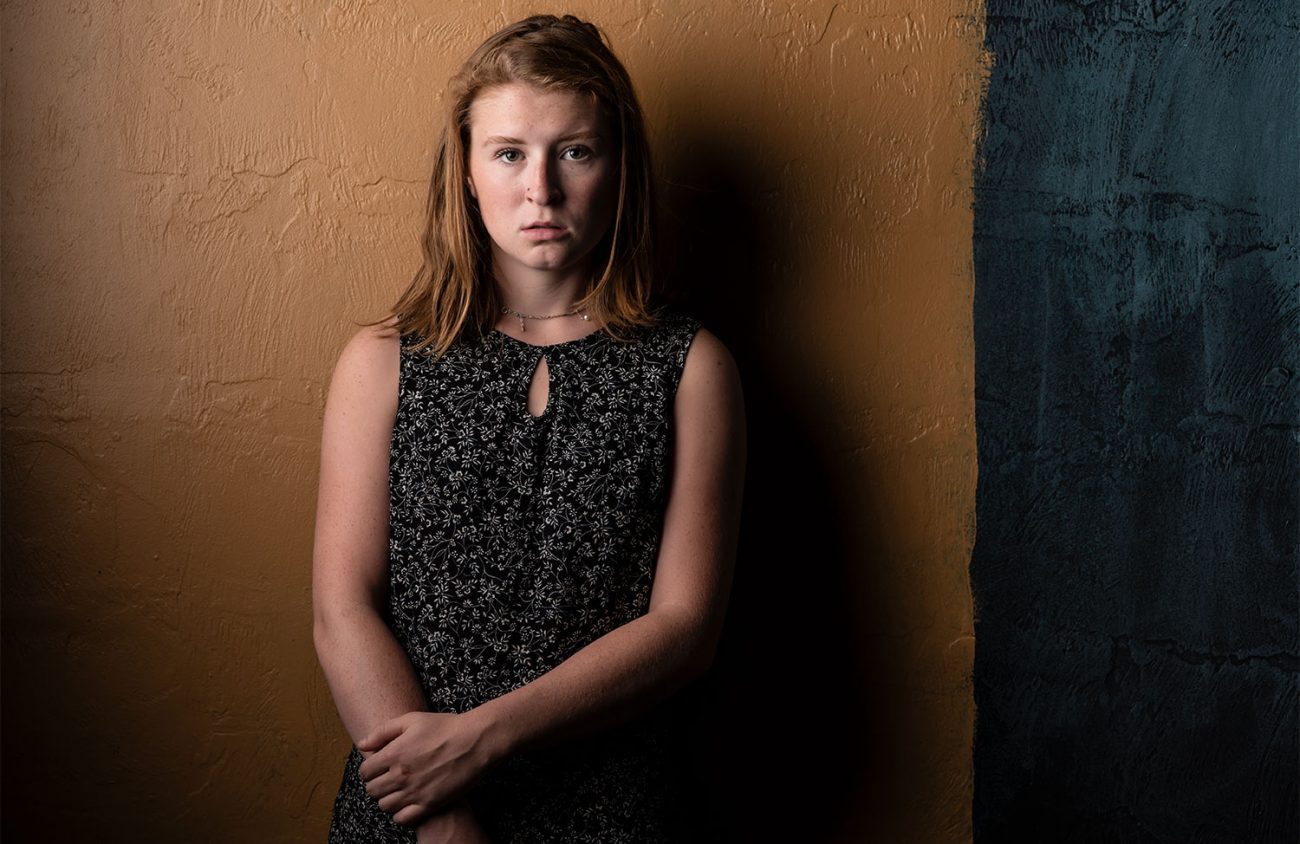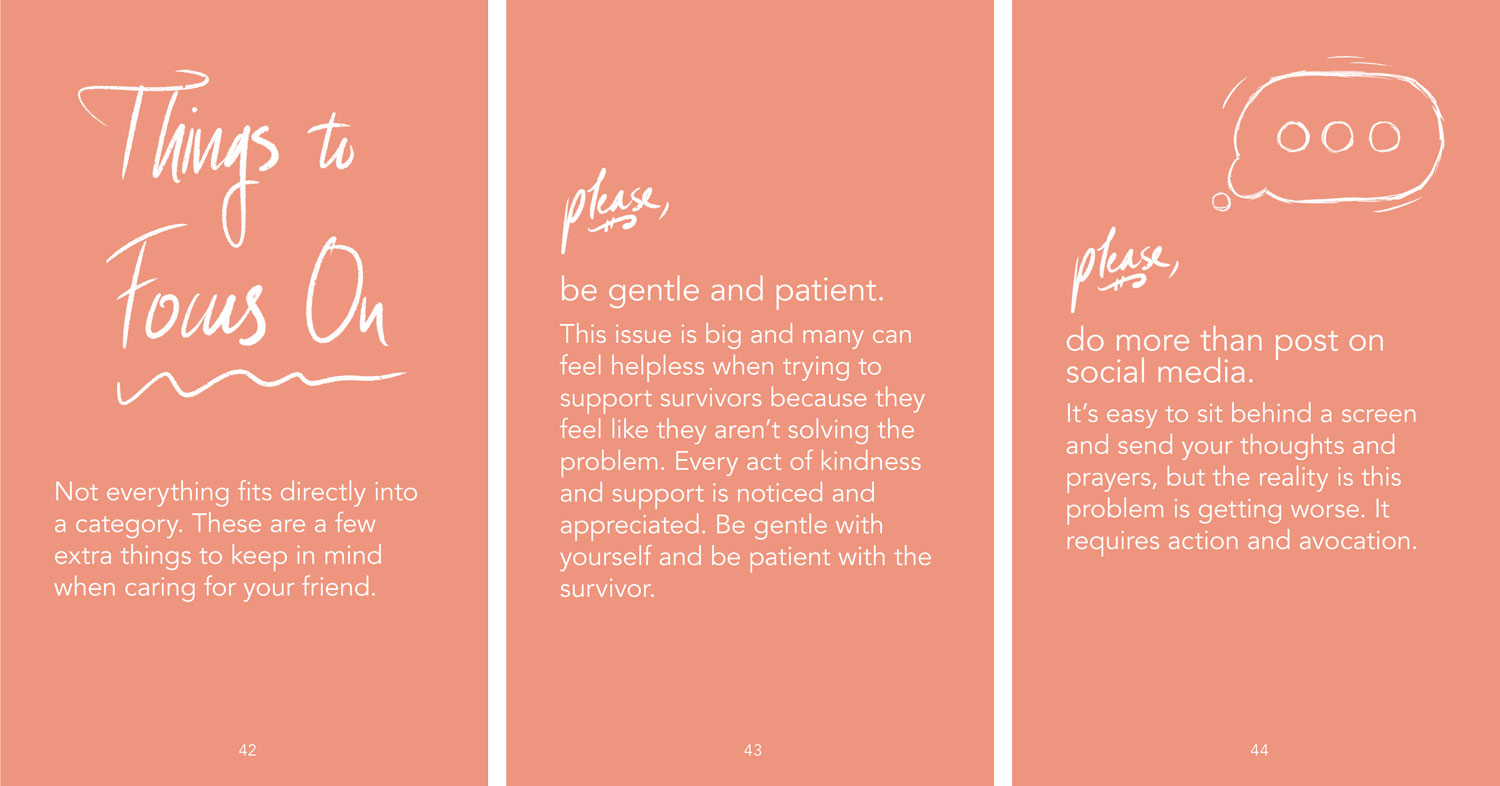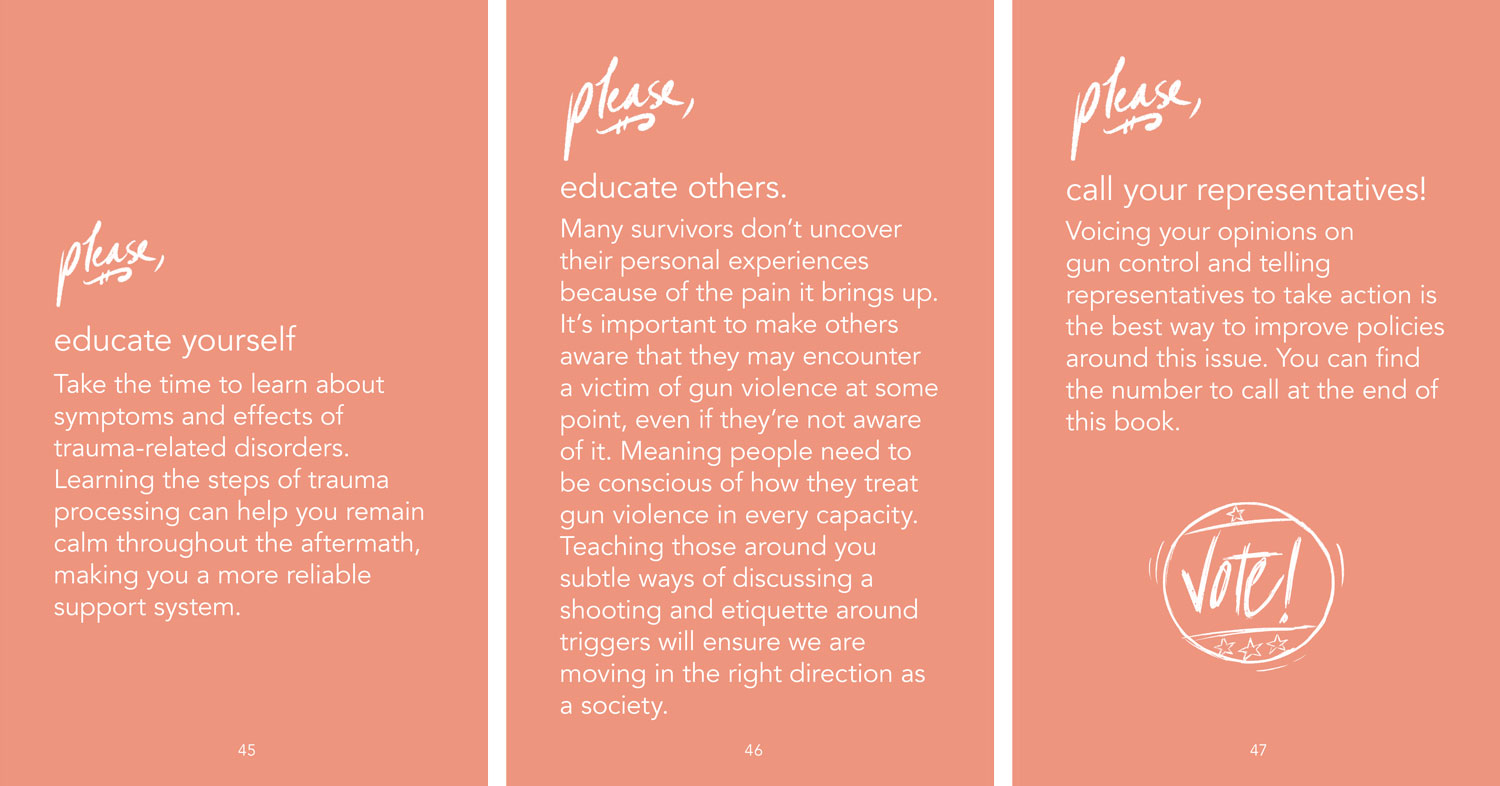Meet Hannah
A single moment, a single choice can change the course of your life.
Every day is made up of small moments and small choices that are seemingly inconsequential. Should we go to the annual hometown festival? Should I stop by Walmart today? Go out to the bars downtown?
Often those moments are inconsequential, but sometimes they change the course of your life.
It was a choice so small she probably didn’t even think about it: Through which set of doors should I leave this mall?
When Hannah Baggs was 14, she exited the Macy’s in the Clackamas Town Center near Portland. It was December, and the holiday season had started. A man was entering through the doors as she was walking out. He was wearing a white mask and holding something heavy in his arms.
Baggs came face to face with the man as he ran into the building.
After seven years of not recognizing what effect that single moment had on her life, Baggs, a 21-year-old junior at the University of Oregon, discovered how being in the wrong place at the wrong time has shaken and shaped her, and decided who she’s going to be because of it.
She decided to be an advocate. She decided to write a book.
“I’m fine now,” she says. But becoming fine was seven years in the making.
Enlarge

Photo by Tracy Sydor
The Event
Baggs writes in her book that it’s important for friends and family of a survivor of gun violence to have some alternative phrase for the shooting. She calls what happened at the Clackamas Town Center “the event.”
Two hundred fifty active shooter incidents occurred in the United States from 2000 to 2017, resulting in 2,217 casualties, according to FBI statistics.
In that time, places of commerce made up 42 percent of all active shooter incidents. In those seven years, 10 active shooter incidents happened in malls.
One of those shootings was at the Clackamas Town Center in Happy Valley, an unincorporated community, on Dec. 11, 2012.
On that day Baggs’ mom, Sharon Baggs, picked her up from a day of class at La Salle Catholic College Preparatory. Hannah got in the car and they were off, en route to the mall so she could buy new underwear before going home.
They parked on the second level and walked past a man from the Salvation Army. He was ringing a bell and asking for donations. He held the door open for them, and they walked into the center through the Macy’s entrance, like they always did.
They did their shopping at Victoria’s Secret and walked back through Macy’s to exit. They were on their way out when Baggs’ mom stopped just before the exit to look at the purses.
When leaving this particular part of the mall, you have the choice of four sets of doors. It’s the kind of choice no one ever really thinks of. Which set of doors should I go through?
Baggs walked ahead of her mom. She approached the second set of doors from the right and her mom, a ways behind her, approached the second set from the left. Through the glass door, Baggs caught a glimpse of the bell ringer outside.
Coming through the door was a man in a white plastic mask, holding an AR-15.
The 22-year-old gunman was on his way in, carrying the assault-style rifle. He would go on to kill two people and wound a third in the shopping mall that day.
“He pointed it at me and we made eye contact, and then he ended up running the other direction,” Baggs says.
Jacob Tyler Roberts waited to fire any shots until he was out of Macy’s and inside the open atrium that housed the food court. He fired at least 16 shots out of the 145 rounds he carried before his gun jammed.
Steven Forsyth, 46, was working at his kiosk selling custom-made coasters. He was on the phone with his dad when Roberts shot him in the head, killing him. Cindy Yuille, 54, had stopped by the mall to pick up some last-minute Christmas presents. She was hit in the back and killed by what family members were told was a “stray bullet.” Kristina Shevchenko, 15, was wounded passing through the Town Center to get to the MAX.
Roberts got the gun un-jammed and he fired one last shot in a service hallway, taking his own life.
By then, Baggs would be home, calling her sister Becca. Her mom would be turning on the news.
Still, that moment in the doorway felt longer than the 22 minutes that came after, the amount of time media reports say it took for Roberts to do his damage.
After all, the run-in was only a few seconds. But, Baggs says, “I feel like we stood there for a long time.”
Baggs’ mom didn’t see the interaction. She was farther behind and passing through a different set of doors. After Roberts ran off, Baggs’ mom caught sight of her and knew something was wrong.
“I was, like, white as a ghost,” Baggs says.
They ran out of the Macy’s and to their car. Baggs urged her mom this way and that. They ducked down by their car. “She couldn’t find her keys and I was so, so stressed,” Baggs says.
Finally they got in the car and Baggs put her head down. They drove home, trying to Google what was happening inside the mall.
“I don’t even remember, like, if we talked,” she says. “I don’t think that we said anything.”
When they arrived home, her mom turned on the Channel 2 news to find out what was happening at the mall. Oregonian sports columnist John Canzano, who happened to be at the mall when the shooting started, reported that a gunman was in the Clackamas Town Center.
That night at the Baggs residence the house phone wouldn’t stop ringing. Baggs’ mom told her brother, who worked with Canzano in the sports department at the newspaper, what had happened. Reporters all over wanted to talk with her.
But they would all have to wait.
Baggs was busy rehearsing her role as Lucy in a production of The Lion, the Witch, and the Wardrobe. Her mom had emailed the director before rehearsal to let him know what had happened. “I just wanted them to be sensitive to her,” she says.
After rehearsal, her parents asked what she wanted to do about all the phone calls. Baggs says, looking back at that moment, “At that point I was numb about it, like I hadn’t quite processed it. I was just like, ‘Let’s just do one of them and make them stop calling.’”
The Today Show came to her house that night. They had her sit and told her they wanted to get some footage of her texting her friends. Her friends didn’t even know. Baggs pretended.
Baggs’ mom says that after the Today crew left they got ready for bed and slept with the hall light on. “I mean, you can’t close your eyes and go to sleep. You just lay there and think, ‘That was the weirdest thing that happened,’” Sharon Baggs says.
Baggs went to school the next day. “Someone came up to me [at school] and they were like, ‘I saw you on the Today Show. That’s so cool!’ and I remember I was like, ‘No it isn’t. That’s not the reason I want to be on it.’”
Her friends didn’t seem to understand, either.
“All my friends, I think, at the time kind of romanticized it because they didn’t quite know how to take it and so I didn’t try to process it on a serious level,” Baggs says.
That night she went to rehearsal again.
“Everyone was like, ‘Why didn’t you tell us yesterday?’ They were like, ‘You seemed fine.’” She continues, “What was I going to do, sit in rehearsal like, ‘What did you guys do today? I…‘” she trails off in a half laugh.
How do you tell someone you came face to face with the guy who killed two people in the mall?
How do you tell someone you could have been the first person he shot?
“But they… they were nice. Like, I think it was good that I had something I was doing at the time because then I had to kind of just like keep going.”
Baggs’ school offered her counseling right after the event, but she didn’t pursue it. Baggs’ mom says that to work through it, Baggs was “acting it out.” As her mom recalls, her director would ask her to “go to a really dark place, a place where… you were really afraid.”
Baggs would later say that though it was helpful at the time, acting it out also led her to act like she was OK when she wasn’t.
From Victim to Survivor
Weeks after the event, Baggs was jumpy. She’d have nightmares. She would round a corner at school and think she saw something. “I would always take a friend to go to the bathroom and I… was just very anxious.”
The anxiety settled, and Baggs went on with life as usual.
Baggs very well could have been the first victim on that Tuesday in December at the Town Center.
The American Psychological Association says survivors of mass shootings are at greater risk of mental health problems. About 12 percent of survivors will experience PTSD, which is higher than the average rate of PTSD prevalence in survivors of other types of trauma.
Survivor’s guilt is something experienced by a lot of people who escape such a situation. This type of guilt has been so strong for some victims that they have taken their lives.
Baggs remembers thinking in the aftermath of the shooting, “I don’t think I deserve to be alive right now.”
She says she believed that everything happens for a reason. Her thinking at the time was that she was meant to die, and she didn’t. The idea that something was supposed to happen and didn’t happen stirred a lot of guilt and anxiety in her.
Six years passed before the event affected her life in any major way, though it was always with her. On every first day of school, Baggs would go up to her instructors and make them aware of her triggers.
Mostly, though, she had it under control.
But on Feb. 14, 2018, an armed student killed 17 people at Marjory Stoneman Douglas High School in Parkland, Florida. It was a topic Baggs couldn’t escape in class.
After that, she began to feel unsafe on her university campus. “We don’t do drills for it. Like, what do you do if it happens? We don’t know.”
It wasn’t just campus. The number of places in which Baggs felt safe was dwindling.
“I wouldn’t go to parties,” she recalls. “I wouldn’t go to concerts. I wouldn’t go — even going to class, I really didn’t want to do. Going to dining halls I didn’t want to do — just like anything.”
Her friends didn’t seem to understand why she didn’t want to be in crowds or see a movie with a masked man in it. And Baggs didn’t understand why, after all this time, it bothered her so much.
She texted her older sister, Becca, 24, about brushing her teeth and seeing another person in the mirror. She told Becca about walking to campus and thinking she saw someone with a gun.
“Her personality and her mood changed significantly” during this time, Becca says. She would take her feelings out on people, and that took a toll on her relationships.
During that school year, Baggs texted Becca often about how she was feeling.
“She would come to me and talk to me about it, and I didn’t know the best way to handle it,” her sister says. She suggested Baggs talk things out with a counselor. But Baggs still didn’t go.
That winter, Baggs went back to the Clackamas Town Center with her family. They ate at the Cheesecake Factory and, as they were leaving, they discovered the whole parking lot was shut down. There had been an incident involving a gun in the parking lot, and police were keeping mall patrons away until it was all sorted out.
“I remember I started, like, hysterically crying. It was the same parking lot,” Baggs says.
After months of her sister’s suggesting she talk to someone about what she was going through, Baggs told her mom she wanted to go to counseling.
At the end of eight weeks of sessions, Baggs’ counselor asked her to write two lists. One would be questions she had about the shooting. The other would be things she would describe as making up a happy life.
From that second list she realized one thing. “I want to be able to use whatever I’ve gone through to advocate for people,” Baggs says. “When I would go through counseling, she’d be like, ‘Tell me about your friends who were there for you,’ and I’d be like, ‘Well.’
As Baggs recounted her memory, her voice went up three octaves as she said the word.
“And then she would ask about my parents and I would be like, ‘Well, they tried really hard to be supportive, but also they don’t understand,’” she says.
“A lot of other people probably feel this way, so why don’t I start advocating for other people who are feeling upset?” she thought.
Baggs started a new list, one that outlined the things that people did to help her or understand her when she was first processing the shooting. She wrote down whether those things were helpful for her.
The Handbook
That list would be the catalyst of her book, The Handbook: Empathy and Support for Survivors of Shootings. It’s a small, gray-and-peach colored handbook with easy-to-digest text and hand-drawn graphics.
Basically, it’s the exact opposite, in aesthetic, of any gun violence pamphlet or website you’ve likely seen.
The goal of The Handbook was to invite you in. It had to have color, but not color that was attached to anything. So no red, because red was attached to blood. Pink wouldn’t do because it appeared too girlish, and Baggs wanted to be taken seriously as an advocate and a writer.
Baggs chose gray because it’s neutral, and white for the type color because it’s clean and fresh.
Now, contrast that with a simple Google search for “resources for survivors of gun violence.” One of the first results is the resources page for EveryTown for Gun Safety, an advocacy group working to end gun violence. The webpage is light pink with heavily weighted red text. Though the content is informative, it isn’t exactly inviting.
Another top result is the Gun Violence Trauma page of the American Counseling Association. It’s a fairly cut-and-dried list of hotlines and resources, but it’s not something that holds your hand and says, “I get it.”
Baggs couldn’t find what she was looking for, so she made it.
She decided to make for others what she wished she had when she was searching for resources.
Writing it was cathartic for Baggs. “It was me being, like, ‘OK, this horrible thing happened. I processed it. I made sense of it. Here’s me kind of putting it into something good.’”
She writes in her book that she had the best-case scenario: She lived.
She didn’t even get shot. So why did she still feel awful?
Therapy, Baggs says in the handbook, helped her work through the guilt she felt. But therapy won’t always be there. Your family and friends will, and they’re the ones who have to understand how to be there for survivors.
“I just remember that I was like, ‘Wow, like, that was so, so helpful. Counseling did me wonders. But it also opened up a lot of space for me to realize that, like, I [was lacking] so much, like, basic empathy and basic, like, support when it happened,” Baggs says.
“I was like, ‘Oh, shit, you know, realizing now that it took seven years for me to process it.’ And that’s how long it takes for things to go into long term memory. I figured it must take a lot of other people a long time. So I was like, ‘OK, I’m kind of ahead of the curve of like, figuring this shit out.’”
The handbook is also of personal benefit to Baggs because it allows her to tell the story for herself.
“It’s one of those traumas that’s not private. Anyone could figure it out. If people Google me, they’ll find it.”
Sure enough, you type Hannah Baggs into the Google search engine and the eighth hit, after her Squarespace portfolio and various social media accounts, is The Oregonian article with the headline: “Witnesses tell their stories from Clackamas Town Center shooting.”
Baggs is quoted once.
Now
Hannah Baggs walked, smile beaming, into Espresso Roma, a cafe just a block off campus. She had with her that small gray handbook, with white handwriting on the cover. It had just been printed.
“People shouldn’t have to ask for support,” she writes in the handbook. “But also, I think that it’s kind of, like, childish to assume that people should know how to handle this situation, because it’s not a normal situation.”
The handbook addresses both those needs.
For Baggs, the handbook marks the beginning of a new chapter in her life, one where she advocates for people.
“I want to do the work for the people who can’t do the work yet.”
The last section of The Handbook is titled “Going Forward.” In it, Baggs asks others to share with her their stories of journeying from victim to survivor. She hopes to make a second book that compiles those stories to change the conversation around gun violence.
You can read The Handbook: Empathy and Support for Survivors of Shootings at hannahbaggs.com. The handbook was designed by Benj Zeller.


